|
| |
Family Cicadidae
- This page contains pictures and information about Double Drummer Cicadas that we found in the Brisbane area, Queensland, Australia.
-
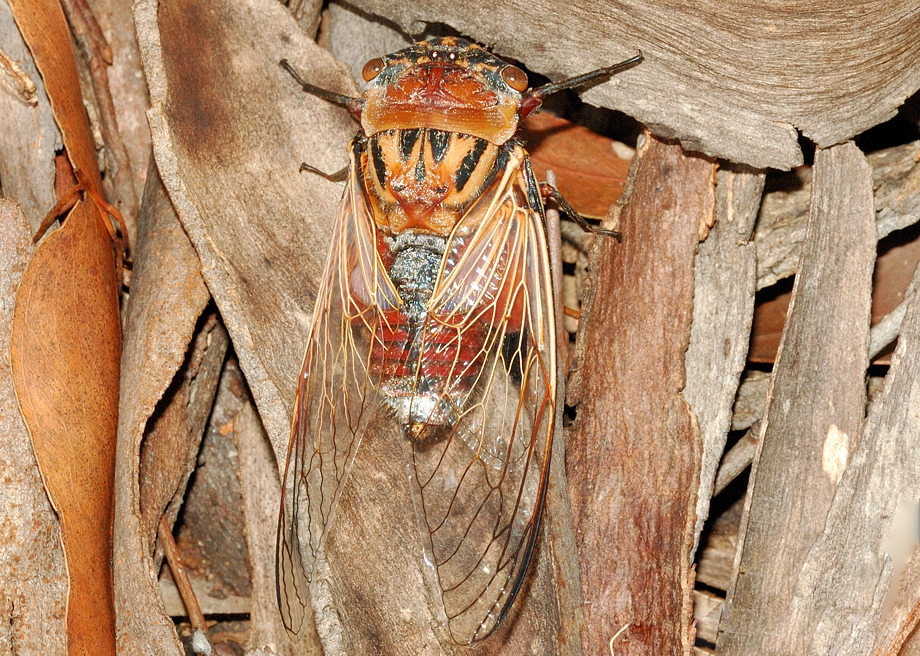 - Male, body length 45mm
-
- Double Drummer Cicadas are the largest cicadas in Australia.
They make loudest sound in the insect world. They are brown to orange-brown in colours with black pattern. On each side of the males' abdomen there are the small pockets, the
double drums, which are used to amplify the sound they produce. Females do
not have the double drums but with longer abdomen tip.
-
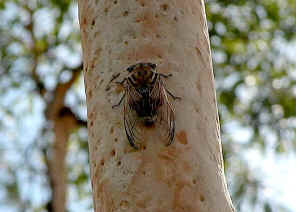
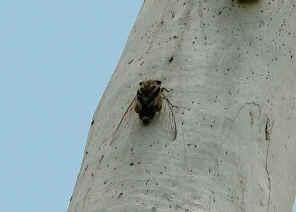
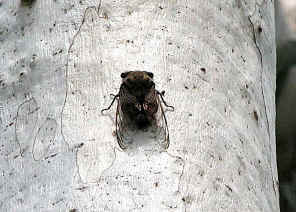 -
- Those large cicadas may not be seen easily because they usually stay on
tree top. However, we always know they were there by hearing their loud
songs. Their song is loud,
piercing, chainsaw-like whine, which fluctuates smoothly in pitch. Singing occurs
throughout the day and also at dusk in summer season.
-
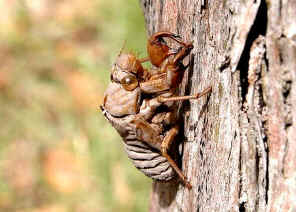 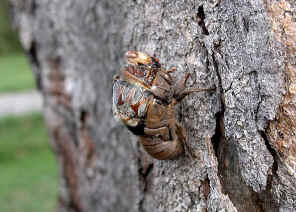  - Empty nymph skins (also known as Exuviae)
-
- We may not see them easily. What we usually noticed were their empty nymph skins (called exuviae)
left near the base of large tree trunks. The second
picture shows a dead cicada. It was stuck on its last molting. Double
Drummers form
large local aggregations in tall open, dry eucalypts forests,
heathlands and woodland. Different broods emerge in
different patches of forest each year.
-

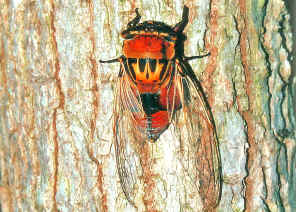 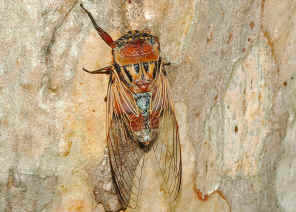 -
- The Double Drummer product loudest song. In mid summer, they can be
found gather a few meters high on large eucalypt trees. Usually they
stay high on the large gum trees and make the sound during the summer days.
They inhabit Eucalyptus and Angophora trees, preferring those
large gum-trees with smooth bark. They tend to aggregate on upper part of
tree trunks. They are active fliers. Listen, look up and watch you might found them flying
between tree tops.
-
Male and Female
- On each side of the males' abdomen there are the small pockets, the
double drums, which are used to amplify the sound they produce.
-
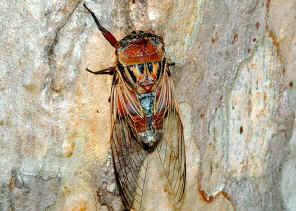 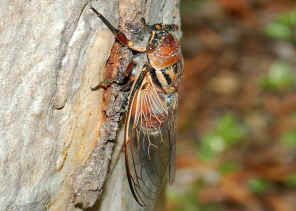
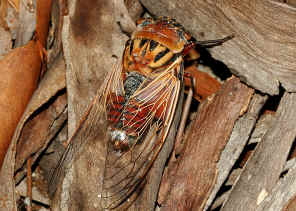 - Male
-
- This is the males who sing the
songs to attract females. Only males have the sound producing organ but
both males and females have the hearing organ. Each species have different 'songs' which are
produced by two organs called timbals on each side of their abdomen. The sound
is produced by a mechanism working like the children tin clicker toys. The
male cicadas vibrate the membranes by internal muscle and the sound is resonate
with the drum-like cavity and this amplify the sound. The songs are
primarily for finding mate, but may also for aggregation of males and repel
predators.
-
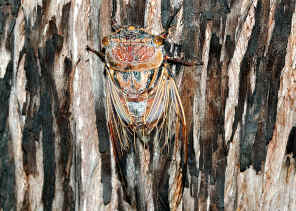
 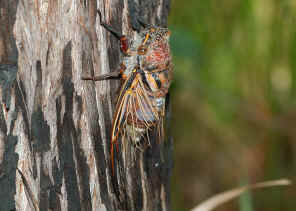 - Female
-
-
Females look similar to males. Females do
not have the double drum but have longer abdomen tip.
-
-
Nymphs live in ground and burrow within soil. They have strong fore
legs to move in the soil. The young nymphs live underground suck the roots of trees.
Some other species have the annual life-cycle, but the Double Drum Cicada
nymphs were believed live underground for many years. The exact length of their life cycle
(i.e. number of years) is unknown yet.
-
Double Drummer in Karawatha Forest 2007
- We heard the Double Drummers' song every summer in the forest, but their
number seems especially high in Dec 2007.
-
 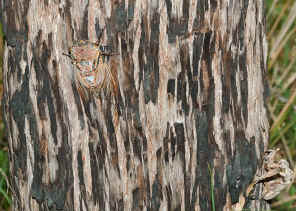
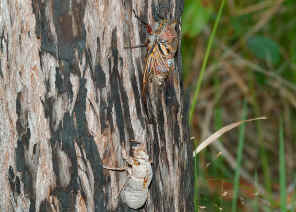 -
- On end Dec 2007 in Karawatha forest (we believe it would be the same for
most other forests in Brisbane), many adults emerge together and
clusters of empty nymph skins (called exuviae) were seen around the base
of tree trunks. We had been visited the forest every week for the last few
years and did not remember seeing so many exuviae, although we noticed
those Double Drum Cicadas had started singing few weeks ago.
-
- Every medium to large size tree trunks, at least two or three exuviaes
were found. Some large tree trunks had more than 20. Some exuviae were even seen on tall
grasses and vertical rock surfaces.
-
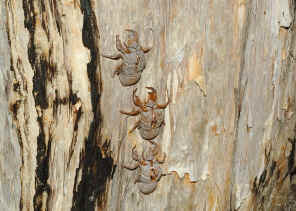
  -
- We also saw many new holes of diameter 25mm on footpaths in the forest.
There were many similar holes on the forest ground inside the forest but not seen
for they are covered by fallen plants materials.
-
- We also saw some of those cicadas flying between gum tree
tops. Some areas in the forest, the songs were so loud that we could not hear each other when we talked closely face to face.
-
- Most cicada species, including this Double Drummer, emerge at night till
sun raise. In that day 10:00am in the morning we still saw some Double
Drummers resting on tree trunks near the ground. They just emerged and were
waiting for the wings and skin to be harden. We also saw one cicada
emerging, details are recorded as below.
-
Cicada Emerging
- In general, just before emerging, those matured nymphs will dig their way
from the root underground where they live and move to just below the soil
surface. They may be waiting for some environment signals or conditions to
emerge. Then suddenly all of them are synchronized together and come out
from the ground. They find the closest vertical surface, such as a large
tree trunk, climb up about half a meter then start to emerge to become
adults.
-
- Most cicada species, including this Double Drummer, emerge at night. The
cicada in the following pictures could emerge a bit later than normal. It
had already emerged outside the exuviae when we first saw it.
-
 
 - 11:00am already emerged outside exuviae, head downwards.
-


 - 11:10am wings started expanding, head moving upwards, wings half opened, new legs grab the exuviae.
-
 
 - 11:15am wings fully opened
-


 - 11:16am wings became dry and clear, still soft, we saw the double drums -
it's a boy!!
-
- 11:30am wings folded into tent shape position.
-
- Then the cicada would keep in this position until both its wings and skin
were harden. Its pale body colour would become darken after a few hours.
-
- Reference:
- 1. Genus
Thopha - Amyot and Serville, 1843 (Drummers) - The cicadas of central eastern
Australia, L. W. Popple, 2006
- 2. Cicadas
– our Summer Singers - Geoff Monteith, Queensland Museum, September 2000.
- 3. Species
Thopha saccata (Fabricius, 1803) - Australian Faunal Directory, Australian Biological Resources Study.
- 4. Wildlife of Greater
Brisbane - Queensland Museum, Brisbane, 1997, p79.
- 5. Australian Cicadas - Moulds MS (1990). New South Wales University Press, NSW. Australia.
-
- Back to Top
[ Up ] [ Double Drummer ] [ White Drummer ] [ Razor Grinder ] [ Black Friday ] [ Black Prince ] [ Clanger ] [ Brown Bunyip ]
| |
|


































